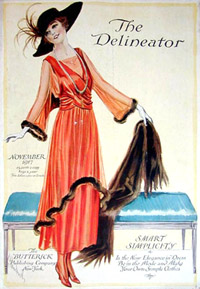 The Delineator (New York, NY, USA)
The Delineator (New York, NY, USA)
- Cookery (Aug 1922)
- Christmas Day at Sea (Dec 1923)

November 1917
The Delineator: A Journal of Fashion, Culture, and Fine Arts was launched in 1873 by Ebenezer Butterick, a publisher and manufacturer of sewing patterns. Contributors included: L. Frank Baum, Charles Roberts, Zona Gale, Hamlin Garland, Anthony Hope, Carolyn Wells, Mary E. Wilkins, Arnold Bennett, Hall Caine, William MacLeod Raine, Amelia Barr, Richard Le Gallienne, Joseph Lincoln, and Jack London. In the early 1920s, the magazine increasingly published the work of romance novelists such as Kathleen Norris, Maud Lovelace, Albert Payson Terhune, and Sophie Kerr. Rose O'Neill, Arthur Rackham, John Held, Jr., and Howard Chandler Christy were among the many distinguished illustrators on its staff. Prior to its merger with William Randolph Hearst's Pictorial Review in 1937, The Delineator was edited by Robert O'Loughlin (1873-1884), H.F. Montgomery (1885-1894), Charles Dwyer (1895-1906), Ralph Tilton (1906), Theodore Dreiser (1907-1910), Honore Willsie Morrow (1914-1920), Mary Mattingley Meloney (1920-1926), Loren Palmer (1926), and Oscar Graeve (1927-1937).
Originally a magazine of women's fashion, supplemented by dressmaking cutouts and paper dolls, The Delineator began including fiction in 1896 and serials in 1902. There followed a series of features on 'women's issues', successful women, social campaigns, and women in sport and cultural life. In 1923, it even published a series of essays by Vice-President Calvin Coolidge on fighting Communism. With a circulation rising from 480,000 in 1900 to one million in 1920, its editors boasted 'more advertising than was ever inserted in any magazine published for women at any time, anywhere'. By 1912, the Butterick Publishing Company was publishing The Delineator in English in the United States, Britain, and Canada markets as well as in French (Le Miroir des Modes), German (Moden Revue), and Spanish (El Espejo de la Moda). Commanding a national and international network of offices, The Delineator was, indeed, as Lynn O'Neal Herberling notes, 'a magazine of American fashion for the world'.
In June 1922, The Delineator's editor Mary Meloney paid Conrad a visit in order to 'talk business' about his 'next novel' (Suspense) and to discuss an offer to buy film rights to The Rescue with a royalties arrangement of 50%. 'She is so American that I found it as difficult to get to terms with her as with a photograph,' Conrad told his agent: 'However I don't suppose she was dissatisfied with her visit' (CL 7:120). A short article about Conrad by Meloney appeared in The Delineator on 11 August. That same month, The Delineator published Conrad's essay 'Cookery' as part of its serialization of A Handbook of Cookery for a Small House (August 1922-January 1923) by his wife Jessie.
Sources
Clear, Richard E. Old Magazines: Identification & Value Guide. Second Edition. Lakeville, Minn.: Astragal Press, 2006.
Davies, Laurence, et al., ed. The Collected Letters of Joseph Conrad. Cambridge: Cambridge University Press, 1983-2008. 9 vols.
Gordon, Sarah A. 'Make it Yourself': Home Sewing, Gender, and Culture, 1890-1930. New York: Columbia University Press, 2007. Available free online from Gutenburg-e here. Herberling, Lynn O'Neal. 'The Delineator'. Women's Periodicals in the United States: Consumer Magazines. Ed. Kathleen L. Endres and Therese L. Lueck. Westport, CT: Greenwood Press, 1995. 58-67.
Mott, Frank Luther. A History of American Magazines, Volume IV: 1885-1905. Cambridge, Mass.: Harvard University Press, 1957.
Russell, Richard and Elaine Gross. Vintage Magazines Price Guide. Iola: K.P. Books, 2005.
For the Fiction Mags Index's gallery of Delineator covers, click here.
For a contents listing for 1898-1928, click here.